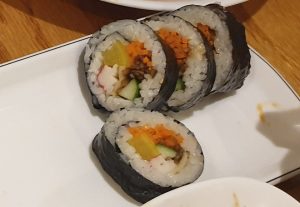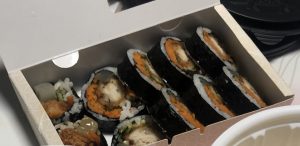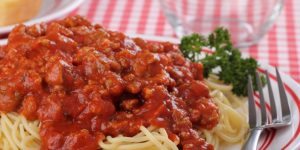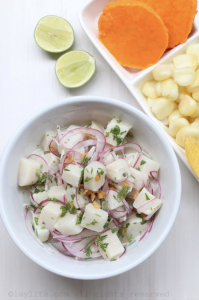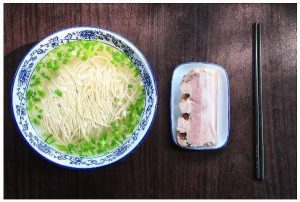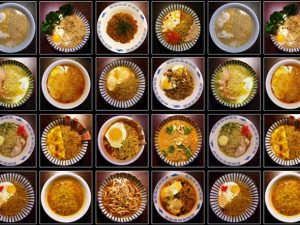
With the continual running of the history river, noodles had been constantly evolving into different shapes in various parts of the world. The production methods of noddles, the cooking methods and the combination with other ingredients made noodles unique from regions to regions. In this week’s reading, I was exposed to both noodles in China and in Italy. By closely observing the hand-making and cooking process, I came to realization about the cultural indication of the noodles.
For Chinese noodles, it is a great reflection of Harmony, one of the most important principles in Chinese cuisine. According to “Noodles, traditionally and today”, the author Na Zhang writes, “when cooking noodles, we can add eggs, vegetables, and other ingredients, so as to make noodles achieve the principle of ‘food diversification’, and promote health for people (Zhang 2).” Chinese noodles has rich content, ranging from various vegetables and meat. Maintaining a balanced diet is the key to harmony of everyone’s life. In the same reading, Zhang mentioned Beijing fried bean sauce noodles, which perfectly illustrates balance and harmony. In this type of noodle, it has carrots, cucumbers, green beans and sprouts for vegetables. The sauce contains minced pork and beans to provide the necessary proteins. Chinese noodle can always match vegetable and non-vegetable and there is a proper proportion for the amount of soup, noodles and other ingredients. Different types of grains, meat, and vegetables were cooked in different ways such as frying, boiling or eating in a cold soup.
Chinese noodles also reflect how people perceive food as medicine. According to the reading “Noodles, Pressed and Pulled”, the beef soup that was used to cook contained 10 kinds of spices and herbs, and many of them were used for traditional medicine (Lin 4). This specific type of noodles originated from Gansu province, where a lot of Muslim resides. Because of their religious practice, Muslims do not eat pork. Therefore, all the hand pulled noodles use beef stock to add the flavor to the noodles. In this way, when people eat the noodles and drink the stock, their body can absorb all the nutrients at the same time.
Different regions eat various types of noodles is also caused by the environment. For example, according to the reading “Dan Dan Noodles”, the author Dunlop described how the people in Sichuan province are more inclined to eat spicy food because of the dampness within their body (Dunlop 7). The chilly sauce from the Dan Dan noddles will cause people to swear continuously, which accelerates the process of metabolism to get the water out of human body system. There are more surprising types of noodles that come with certain stories. For example, Sao Zi Mian was used to reminds those that failed to pass the test of their shameful actions. Noodles in China can also contain auspicious meaning, such as longevity. In our previous reading, the Long-life Noodles, although the author did not live an ideal life, but his life span surpasses everyone in his family, reflecting the idea of consuming long life noodles.
In Italy, pasta signifies the unity of the nation and also the variety of its culture. Based on the reading “Spaghetti Pasta Macaroni”, pasta is a singular type of noodles. However, it has hundreds of different forms scattered all over Italy just like hundreds of small states in those areas before Italy was unified (Montanari 6). Each specific shape of pasta also serve different purposes as to accompany the corresponding sauces. The pasta with rough surface will hold on to the creamy rich sauce, and the pasta that has smooth surface goes well with simply olive oil in salad. By sharing this common type of food and making use of the diverse tradition, Italians transform pastas to a symbol of their own identities. In the meantime, variations can occur, which defines the identity in hundreds of other ways. Names of the pasta also plays a significant role in pasta’s history. Some names were created to commemorate the results of industrialization such as eliche pasta and route pasta. Others are named after the city to signifies its prosperity and complicated history (Abecassis 23).
Noodles played such an integral rule in both China and Italy due to its health benefits and diversity. Coming from grind grains such as wheat, semolina or millet, the noodles contain complex carbohydrates, which helps to keep the person’s stomach feel full for a longer period of time, while providing sufficient energy. The flour can also be mixed with eggs, which are treated as source of protein. Then, pairing noodles with local vegetables, meat and even fruits can create hundreds of dishes and keep people’s body in a good shape. By consuming noodles as a main source of diet, people can easily gain enough nutrients that they need. There are also different kinds of noodles that are accessible to the public all over the world. Although the climate varies between regions, people can still different types of grains in certain region and use the seeds to make noodles. Therefore, the major ingredients that are needed to make noodles are not hard to find around the world. Another reason that contributes to noodles’ significance is the cooking methods are easy to learn and takes less time. By boiling a pot of water and put the noodles in, waiting for a few minutes, you can easily receive a delicious meal, which solves many young people’s problem with lacking time.
In order to define noodles, we should understand the clinical definition—a strip, ring, or tube of pasta or a similar dough, typically made with egg and usually eaten with a sauce or in a soup. Flour and water are two fundamental ingredients to make up the noodles, but the cultural definition and linkage are much more important than the structural definition of noodles. There must be a group of people that shares the same method to make and to cook certain type of noodles. Their recipes can be a bit different to indicate how versatile the noodles are. According to chef Lombardi, noodles are “a universal food, complimentary to many other foods, and adaptable to many cuisines around the world.” His statement best defines all aspects of noodles and helps me to give a explicit definition for noodle, which is a comfort food that can be adjusted to everyone’s preference while developing a strong cultural connection with the people who are consuming it.
I choose the following picture as a representation of noodles. Nowadays, people do not have time to make noodles from scratch, and the experience of this fun process is part of the noodles true meaning. All the instant noodles that are sold in the market currently preserved the major flavor of all kinds of noodles, which is a reminder for those people who are busy with their work to feel the amazing taste of this type of food. The instant noodles that are sold in different countries can also be treated as a symbol that represents the local flavor as well.


